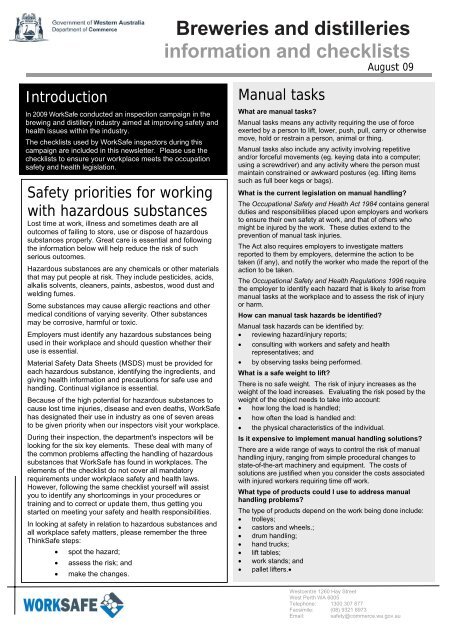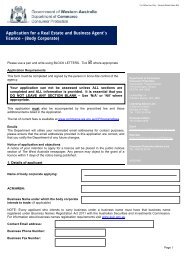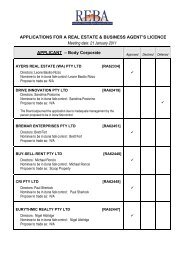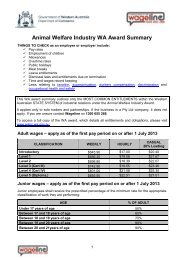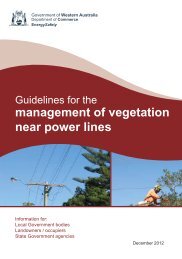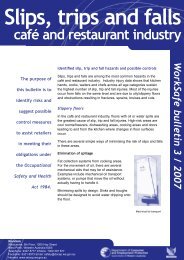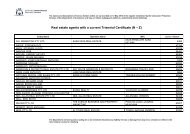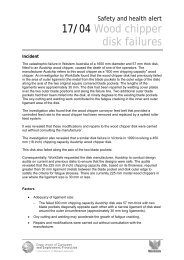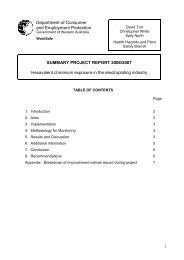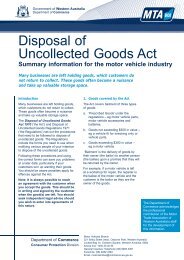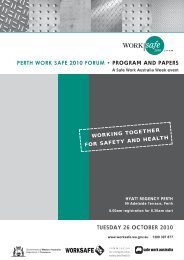Brewers and distillers information and checklist - Department of ...
Brewers and distillers information and checklist - Department of ...
Brewers and distillers information and checklist - Department of ...
You also want an ePaper? Increase the reach of your titles
YUMPU automatically turns print PDFs into web optimized ePapers that Google loves.
Introduction<br />
In 2009 WorkSafe conducted an inspection campaign in the<br />
brewing <strong>and</strong> distillery industry aimed at improving safety <strong>and</strong><br />
health issues within the industry.<br />
The <strong>checklist</strong>s used by WorkSafe inspectors during this<br />
campaign are included in this newsletter. Please use the<br />
<strong>checklist</strong>s to ensure your workplace meets the occupation<br />
safety <strong>and</strong> health legislation.<br />
Safety priorities for working<br />
with hazardous substances<br />
Lost time at work, illness <strong>and</strong> sometimes death are all<br />
outcomes <strong>of</strong> failing to store, use or dispose <strong>of</strong> hazardous<br />
substances properly. Great care is essential <strong>and</strong> following<br />
the <strong>information</strong> below will help reduce the risk <strong>of</strong> such<br />
serious outcomes.<br />
Hazardous substances are any chemicals or other materials<br />
that may put people at risk. They include pesticides, acids,<br />
alkalis solvents, cleaners, paints, asbestos, wood dust <strong>and</strong><br />
welding fumes.<br />
Some substances may cause allergic reactions <strong>and</strong> other<br />
medical conditions <strong>of</strong> varying severity. Other substances<br />
may be corrosive, harmful or toxic.<br />
Employers must identify any hazardous substances being<br />
used in their workplace <strong>and</strong> should question whether their<br />
use is essential.<br />
Material Safety Data Sheets (MSDS) must be provided for<br />
each hazardous substance, identifying the ingredients, <strong>and</strong><br />
giving health <strong>information</strong> <strong>and</strong> precautions for safe use <strong>and</strong><br />
h<strong>and</strong>ling. Continual vigilance is essential.<br />
Because <strong>of</strong> the high potential for hazardous substances to<br />
cause lost time injuries, disease <strong>and</strong> even deaths, WorkSafe<br />
has designated their use in industry as one <strong>of</strong> seven areas<br />
to be given priority when our inspectors visit your workplace.<br />
During their inspection, the department's inspectors will be<br />
looking for the six key elements. These deal with many <strong>of</strong><br />
the common problems affecting the h<strong>and</strong>ling <strong>of</strong> hazardous<br />
substances that WorkSafe has found in workplaces. The<br />
elements <strong>of</strong> the <strong>checklist</strong> do not cover all m<strong>and</strong>atory<br />
requirements under workplace safety <strong>and</strong> health laws.<br />
However, following the same <strong>checklist</strong> yourself will assist<br />
you to identify any shortcomings in your procedures or<br />
training <strong>and</strong> to correct or update them, thus getting you<br />
started on meeting your safety <strong>and</strong> health responsibilities.<br />
In looking at safety in relation to hazardous substances <strong>and</strong><br />
all workplace safety matters, please remember the three<br />
ThinkSafe steps:<br />
• spot the hazard;<br />
• assess the risk; <strong>and</strong><br />
• make the changes.<br />
Breweries <strong>and</strong> distilleries<br />
<strong>information</strong> <strong>and</strong> <strong>checklist</strong>s<br />
Manual tasks<br />
August 09<br />
What are manual tasks?<br />
Manual tasks means any activity requiring the use <strong>of</strong> force<br />
exerted by a person to lift, lower, push, pull, carry or otherwise<br />
move, hold or restrain a person, animal or thing.<br />
Manual tasks also include any activity involving repetitive<br />
<strong>and</strong>/or forceful movements (eg. keying data into a computer;<br />
using a screwdriver) <strong>and</strong> any activity where the person must<br />
maintain constrained or awkward postures (eg. lifting items<br />
such as full beer kegs or bags).<br />
What is the current legislation on manual h<strong>and</strong>ling?<br />
The Occupational Safety <strong>and</strong> Health Act 1984 contains general<br />
duties <strong>and</strong> responsibilities placed upon employers <strong>and</strong> workers<br />
to ensure their own safety at work, <strong>and</strong> that <strong>of</strong> others who<br />
might be injured by the work. These duties extend to the<br />
prevention <strong>of</strong> manual task injuries.<br />
The Act also requires employers to investigate matters<br />
reported to them by employers, determine the action to be<br />
taken (if any), <strong>and</strong> notify the worker who made the report <strong>of</strong> the<br />
action to be taken.<br />
The Occupational Safety <strong>and</strong> Health Regulations 1996 require<br />
the employer to identify each hazard that is likely to arise from<br />
manual tasks at the workplace <strong>and</strong> to assess the risk <strong>of</strong> injury<br />
or harm.<br />
How can manual task hazards be identified?<br />
Manual task hazards can be identified by:<br />
• reviewing hazard/injury reports;<br />
• consulting with workers <strong>and</strong> safety <strong>and</strong> health<br />
representatives; <strong>and</strong><br />
• by observing tasks being performed.<br />
What is a safe weight to lift?<br />
There is no safe weight. The risk <strong>of</strong> injury increases as the<br />
weight <strong>of</strong> the load increases. Evaluating the risk posed by the<br />
weight <strong>of</strong> the object needs to take into account:<br />
• how long the load is h<strong>and</strong>led;<br />
• how <strong>of</strong>ten the load is h<strong>and</strong>led <strong>and</strong>:<br />
• the physical characteristics <strong>of</strong> the individual.<br />
Is it expensive to implement manual h<strong>and</strong>ling solutions?<br />
There are a wide range <strong>of</strong> ways to control the risk <strong>of</strong> manual<br />
h<strong>and</strong>ling injury, ranging from simple procedural changes to<br />
state-<strong>of</strong>-the-art machinery <strong>and</strong> equipment. The costs <strong>of</strong><br />
solutions are justified when you consider the costs associated<br />
with injured workers requiring time <strong>of</strong>f work.<br />
What type <strong>of</strong> products could I use to address manual<br />
h<strong>and</strong>ling problems?<br />
The type <strong>of</strong> products depend on the work being done include:<br />
• trolleys;<br />
• castors <strong>and</strong> wheels.;<br />
• drum h<strong>and</strong>ling;<br />
• h<strong>and</strong> trucks;<br />
• lift tables;<br />
• work st<strong>and</strong>s; <strong>and</strong><br />
• pallet lifters.•<br />
Westcentre 1260 Hay Street<br />
West Perth WA 6005<br />
Telephone: 1300 307 877<br />
Facsimile: (08) 9321 8973<br />
Email: safety@commerce.wa.gov.au
Dangerous incidents<br />
Confined space work<br />
A cellar-h<strong>and</strong> was overcome by carbon dioxide after<br />
entering a 4,500 litre wine vat through a 380 mm opening at<br />
the top <strong>of</strong> the wine vat containing crushed grape skins <strong>and</strong><br />
seeds. The juice <strong>of</strong> the crushed grapes had been drained<br />
<strong>of</strong>f through the drainer at the bottom <strong>of</strong> the tank. The<br />
atmosphere was inert due to the presence <strong>of</strong> a large<br />
amount <strong>of</strong> carbon dioxide.<br />
Carbon dioxide is added to the process as an antioxidant to<br />
displace oxygen during the winemaking process.<br />
Factors<br />
• Lack <strong>of</strong> scientific monitoring equipment to test the<br />
internal atmosphere in the wine vats. (Non-scientific<br />
methods such as the sniff test are not satisfactory <strong>and</strong><br />
expose workers to harmful gasses).<br />
• The worker appeared to have a lack <strong>of</strong> appreciation <strong>of</strong><br />
the risks associated with carbon dioxide, that is the<br />
rapidity <strong>of</strong> symptoms, the onset <strong>of</strong> euphoria, loss <strong>of</strong><br />
muscle control <strong>and</strong> death within four (4) minutes.<br />
Recommendations<br />
• Procedures <strong>and</strong> systems <strong>of</strong> work must be developed<br />
<strong>and</strong> implemented for all confined space entry. The<br />
system <strong>of</strong> work must include training <strong>and</strong> provision <strong>of</strong><br />
satisfactory equipment for oxygen measurement <strong>and</strong><br />
personnel rescue.<br />
• The wine industry develop <strong>and</strong> implement a code <strong>of</strong><br />
practice to ensure that there is a greater awareness,<br />
<strong>and</strong> following training, a greater underst<strong>and</strong>ing <strong>of</strong><br />
hazards, risks <strong>and</strong> the management <strong>of</strong> these hazards<br />
<strong>and</strong> risks.<br />
• Australian St<strong>and</strong>ard 2865-1995 "Safe Working in a<br />
Confined Space" is to be used when determining the<br />
suitability <strong>of</strong> a confined space entry system.<br />
• Consideration must be given to a regime <strong>of</strong> safety<br />
inspections <strong>and</strong> audits with a view to ensuring safety<br />
requirements are adequately adhered to <strong>and</strong><br />
implemented.<br />
ThinkSafe Small Business Assistance Program<br />
If you are a small business owner or manager (employing less than 20 full-time employees) <strong>and</strong> want to make your<br />
workplace safe, the ThinkSafe Small Business Assistance Program can help you.<br />
The good news is that the help you get is:<br />
• free (up to three hours assistance);<br />
• easy to obtain;<br />
• provided by an independent <strong>and</strong> qualified osh consultant; <strong>and</strong><br />
• is a simple process with clear <strong>and</strong> immediate outcomes.<br />
To apply download <strong>and</strong> complete the online form from www.worksafe.wa.gov.au or call 1800 429 273.<br />
2<br />
Slips, trips <strong>and</strong> falls<br />
Slips <strong>and</strong> trips can result in serious injury <strong>and</strong> lengthy<br />
amounts <strong>of</strong> time <strong>of</strong>f work. The factors that contribute to the<br />
risk will depend on the type <strong>of</strong> workplace. Common factors<br />
include:<br />
• unstable, loose, or uneven floor surfaces;<br />
• obstacles blocking walkways;<br />
• slippery floor surfaces from spilt substances, fluid, mud,<br />
oil;<br />
• type <strong>of</strong> flooring or surface texture like wood, concrete or<br />
vinyl;<br />
• carrying boxes etc that obscure the view <strong>of</strong> the floor;<br />
• inadequate lighting; <strong>and</strong><br />
• inadequate footwear.<br />
How can I reduce the risk <strong>of</strong> slips<br />
in wet areas?<br />
A risk assessment should be undertaken at the workplace to<br />
determine the specific hazards, level <strong>of</strong> risk, <strong>and</strong> appropriate<br />
controls, <strong>and</strong> all staff should be provided with appropriate<br />
<strong>information</strong> <strong>and</strong> training. Controls may include safe work<br />
practices such as:<br />
• keeping floors, ramps <strong>and</strong> stairs clean <strong>and</strong> dry;<br />
• following procedures for cleaning up spilled substances;<br />
• decanting fluids away from common areas; <strong>and</strong><br />
• wearing footwear suitable to the task <strong>and</strong> surface.<br />
Other controls include providing:<br />
• anti-slip mats;<br />
• adequate drainage;<br />
• restricted access to areas that are potentially<br />
hazardous;<br />
• the right floor surface for the type <strong>of</strong> work;<br />
• adequate <strong>and</strong> well directed lighting; <strong>and</strong><br />
• warning signs.<br />
Regular updates on OSH<br />
WorkSafe has a service that provides <strong>information</strong> on occupational safety <strong>and</strong> health direct to your email. To subscribe to<br />
receive this service go to www.worksafe.wa.gov.au servicesmailing lists
Frequently asked questions<br />
Confined space<br />
1. What is a confined space?<br />
Regulation 3.82 <strong>of</strong> the Occupational Safety <strong>and</strong> Health Regulations 1996, defines a confined<br />
space as an enclosed or partially enclosed space which:<br />
a. is not intended or designed primarily as a workplace;<br />
b. is at atmospheric pressure during occupancy; <strong>and</strong><br />
c. has restricted means for entry <strong>and</strong> exit;<br />
<strong>and</strong> which either:<br />
a. has an atmosphere containing or likely to contain potentially harmful levels <strong>of</strong><br />
contaminant;<br />
b. has or is likely to have an unsafe oxygen level; or<br />
c. is <strong>of</strong> a nature or is likely to be <strong>of</strong> a nature that could contribute to a person in the space<br />
being overwhelmed by an unsafe atmosphere or contaminant.<br />
2. Is there a maximum size area that can be classed as a confined space?<br />
The size <strong>of</strong> a space is not one <strong>of</strong> the factors used to define a confined space. Therefore, there is<br />
no specified minimum or maximum size.<br />
3. What risks might I be exposed to whilst working in a confined space?<br />
A person working in a designated confined space may be at risk <strong>of</strong> exposure to:<br />
electrical shock or electrocution;<br />
oxygen deficiency;<br />
toxic gases or fumes;<br />
engulfment/Suffocation by solids;<br />
fire <strong>and</strong>/or explosion;<br />
drowning in liquids;<br />
falls from height; <strong>and</strong><br />
environmental factors such as noise, extremes <strong>of</strong> temperature, poor lighting, manual<br />
h<strong>and</strong>ling <strong>and</strong> radiation.<br />
4. Do I always need an observer?<br />
Yes. A person should be on st<strong>and</strong>by in the immediate vicinity outside the designated confined<br />
space.<br />
5. Does the person on st<strong>and</strong>by need to have the person working in the<br />
confined space in sight at all times?<br />
As the person on st<strong>and</strong>by has to remain outside the confined space it is not always possible for<br />
them to keep the person/s working inside the confined space in sight at all times.<br />
Continuous communication with the worker/s inside the confined space must be maintained.<br />
Dependent upon the location, communications may be achieved using:<br />
voice;<br />
radio (intrinsically safe one if used in flammable conditions);<br />
mobile phone (not to be used if flammable gas or vapour is present in sufficient<br />
concentration to cause explosion or fire); or<br />
hard wired communications.<br />
3
Locking out <strong>and</strong> tagging equipment<br />
1. What is locking out <strong>and</strong> tagging?<br />
Locking out <strong>of</strong> equipment or machinery is the most effective way <strong>of</strong> preventing it becoming operational during<br />
maintenance. Its effectiveness lies in the "one key per lock, one lock per person" procedure.<br />
If there is only one key per lock, the key has to be with the person carrying out the maintenance. Where more than one<br />
person is working on equipment or machinery a multi-lock system should be followed, ensuring that each person has<br />
attached a "personal" lock to the equipment or machine's multi-lock switch.<br />
All workplaces must have a system unless the equipment or machinery is fully inoperative <strong>and</strong> then disconnected from<br />
the energy source.<br />
Essentially, there are two types <strong>of</strong> tag, the "DANGER" tag <strong>and</strong> the "OUT OF SERVICE" tag.<br />
2. Danger Tags<br />
4<br />
Danger tags are used for a variety <strong>of</strong> hazards that may be involved in equipment <strong>and</strong> machinery maintenance, such as<br />
moving parts, electricity, steam, gas, liquid or toxic substances.<br />
If any work is to be carried out on a particular piece <strong>of</strong> machinery or equipment <strong>and</strong> there is a possibility <strong>of</strong> somebody<br />
inadvertently turning it on, the person carrying out the work must personally fasten a red <strong>and</strong> black "DANGER" tag or<br />
lock to the main isolating switch or valve.<br />
As with locking out, if more than one person is undertaking the work, each person must fit their own personal lock or tag<br />
to the machine. Each tag must be printed with the person's name <strong>and</strong> their section, <strong>and</strong> give the date <strong>and</strong> time it was<br />
attached to the switch or valve. No one must operate a switch or valve that has been locked or tagged "DANGER" until<br />
the lock or tag has been removed, <strong>and</strong> only the person who attached the lock or tag is allowed to remove it.<br />
3. "Out <strong>of</strong> Service" Tags<br />
Yellow <strong>and</strong> black "OUT OF SERVICE" tags are to be used to prevent accidents or damage to machinery that is out <strong>of</strong><br />
service for repairs or alterations. These tags are used in the same way as "DANGER" tags, except that only a<br />
supervisor can remove an "OUT OF SERVICE" tag. If possible, both tags AND locks shall be used. This will provide<br />
both visual <strong>and</strong> physical protection. As a further precaution, a portable sign can also be placed in front <strong>of</strong> the equipment<br />
or machine, or it can be cordoned <strong>of</strong>f with a barrier or rope.<br />
Once a locking-out <strong>and</strong> tagging system has been introduced, it must be strictly enforced. If the system is not always<br />
followed, it becomes ineffective <strong>and</strong> dangerous.<br />
Safety locks <strong>and</strong> tags are readily available from most distributors <strong>of</strong> industrial safety products.<br />
4. Colour Coding<br />
Australian St<strong>and</strong>ard 1318 - 1985 recommends specific colours for the marking <strong>of</strong> physical hazards <strong>and</strong> the identification<br />
<strong>of</strong> certain equipment in industry. Colours used are red, yellow, green <strong>and</strong> blue.<br />
• RED AND WHITE: Signifies danger <strong>and</strong> prohibition, fire protection equipment, stop buttons for electrical<br />
switches <strong>and</strong> emergency stop controls for machinery.<br />
• YELLOW AND BLACK: Signifies caution: draws attention to such hazards as unfastened or removed<br />
machinery guards.<br />
• GREEN AND WHITE: Denotes safety <strong>and</strong> location <strong>of</strong> safety or first aid equipment.<br />
• BLUE AND WHITE: Is for <strong>information</strong> signs where there is no specific hazard.
5<br />
Electricity safety <strong>checklist</strong><br />
check yes no n/a<br />
Electrical installations are installed, constructed, maintained, protected (cover) <strong>and</strong> tested to<br />
minimise the risk <strong>of</strong> electric shock or fire. Evidence <strong>of</strong> maintenance <strong>and</strong> testing in place.<br />
Components clearly marked <strong>and</strong> switchboard free from obstructions.<br />
H<strong>and</strong> held portable equipment is protected by RCD (not construction)<br />
Switchboard or fixed sockets marked whether RCD protected.<br />
Maintenance program in place.<br />
Flexible cords <strong>and</strong> extension cords are used in a safe manner<br />
Connection moulded or transparent plug<br />
Plugs, sockets <strong>and</strong> extension leads in good condition <strong>and</strong> protected from damage<br />
Electrical installations are protected from damage that would increase the risk <strong>of</strong> electrical<br />
shock or fire<br />
The work is organised for the safety <strong>of</strong> workers <strong>and</strong> others at the workplace. Work in the<br />
vicinity <strong>of</strong> power lines <strong>and</strong> plant<br />
Hazardous substances safety <strong>checklist</strong><br />
check yes no n/a<br />
Register <strong>of</strong> hazardous substances is complete (contents list <strong>and</strong> MSDS)<br />
Register is readily available<br />
Hazardous substances are properly labelled: manufacturers labels on container<br />
Decanted containers labelled with name, risk & safety phrases<br />
Risk assessment has been completed for all substances <strong>and</strong> recorded in register<br />
Report is available where risk is significant<br />
Practical control measures have been implemented <strong>and</strong> maintained<br />
Hierarchy <strong>of</strong> control is taken into account<br />
People who may be exposed or work with hazardous substances have been provided with<br />
adequate <strong>information</strong>, instruction <strong>and</strong> training<br />
Record <strong>of</strong> training includes health effects, controls, safe work methods, PPE<br />
Health surveillance is undertaken where appropriate
6<br />
Manual tasks-lifting safety <strong>checklist</strong><br />
check yes no n/a<br />
Practical control measures have been implemented <strong>and</strong> maintained to eliminate or<br />
reduce risk associated with manual h<strong>and</strong>ling work activity: hazard identification, risk<br />
assessment conducted, worker feedback<br />
Accident or hazard investigation is conducted<br />
Everyone involved in organising <strong>and</strong> implementing manual tasks where manual task<br />
hazards have been identified have been provided with adequate instruction <strong>and</strong><br />
training (induction <strong>and</strong> ongoing training)<br />
Mobile plant safety <strong>checklist</strong><br />
check yes no n/a<br />
Mobile plant is maintained to minimise risks. Log book/records, pre-start checks<br />
Evidence <strong>of</strong> training/instruction. License if high risk work.<br />
The plant is a safe condition, Eg Plant registration, access to cab, seat & seat-belt,<br />
FOPS/ROPS as req’d, loadchart as req’d, operator’s manual, controls labelled,<br />
guarding dangerous parts.<br />
Work is organised for the safety <strong>of</strong> employees <strong>and</strong> others. Pedestrian control, traffic<br />
mgt, 2-way communication as req’d, high-visibility clothing as req’d.<br />
Site hazards are identified, assessed <strong>and</strong> controlled (ramps, slopes, rough ground,<br />
power lines, excavations, ground load limits, underground services)<br />
New <strong>and</strong> young workers safety <strong>checklist</strong><br />
check yes no n/a<br />
Induction, <strong>information</strong>, instruction & training emergency/evacuation procedures<br />
Induction, <strong>information</strong>, instruction & training in hazard <strong>and</strong> accident reporting<br />
Induction, <strong>information</strong>, instruction & training in how to reduce the risk <strong>of</strong> injury or<br />
harm for hazards new/young workers may be exposed to in the course <strong>of</strong> their work<br />
Induction, <strong>information</strong>, instruction & training in use, maintenance & storage <strong>of</strong> PPE<br />
Supervision: ensure that new & young workers are working in accordance with safety<br />
instructions including instructions re. skylarking, initiation ceremonies, bullying<br />
Employers ensure the risk <strong>of</strong> injury or harm to (young) visitors is reduced by means<br />
appropriate for the workplace <strong>and</strong> the type <strong>of</strong> work activity
7<br />
Working from heights safety <strong>checklist</strong><br />
check yes no n/a<br />
Practicae control measures have been implemented <strong>and</strong> maintained to eliminate or reduce<br />
the risk associated with work at heights<br />
Hazard identification, risk assessment conducted?<br />
Elimination <strong>of</strong> hazard considered?<br />
Would a fall be arrested before contact with the ground or a structure?<br />
Edge protection required if could fall > 2 metres from scaffold, fixed stairs, l<strong>and</strong>ing,<br />
suspended slab, formwork, false-work. In any other case > 3 metres: FIPS (catch platform,<br />
scaffold, safety nets, safety mesh, fall arrest system) or edge protection provided.<br />
There is safe means <strong>of</strong> access <strong>and</strong> egress to the work being performed at heights<br />
Stairs, walkways, ladders, mechanical lifts, obstruction free<br />
People required to work at height have been provided with adequate <strong>information</strong>, instruction<br />
<strong>and</strong> training for the work being performed.<br />
Slips trips <strong>and</strong> falls safety <strong>checklist</strong><br />
check yes no n/a<br />
Floor or any stair or ramp has unbroken <strong>and</strong> slip resistant surface.<br />
Special provisions for slip resistance provided in wet areas<br />
Floor or any stair or ramp is free from any obstruction that may cause a person to fall (eg.<br />
electrical leads, hoses, floor mounted power boxes in walkways, etc.)<br />
Access to egress from workplace safe <strong>and</strong> at all times kept free from obstructions<br />
Safe systems <strong>of</strong> work (eg. clean as you go policy) in place<br />
Warning signs available <strong>and</strong> erected near spills<br />
Guard rails or other safeguards provided on ramps <strong>and</strong> stairs<br />
Appropriate PPE, such as slip resistant footwear, provided<br />
Ramps in areas where height <strong>of</strong> floor levels change <strong>and</strong> trolley access required or items are<br />
carried regularly<br />
Machine guarding safety <strong>checklist</strong><br />
check yes no n/a<br />
Is every dangerous part <strong>of</strong> fixed, mobile or h<strong>and</strong> held powered plant (machinery) securely<br />
fenced or guarded in accordance with Regulations 4.37 <strong>and</strong> 4.29, except where the plant is<br />
so positioned or constructed that it is as safe as it would be if fenced or guarded?<br />
Are adequate safe work procedures provided <strong>and</strong> documented to set, test <strong>and</strong> use<br />
machinery during all cycles <strong>of</strong> production <strong>and</strong> maintenance? Look for:<br />
• Pre-operational checks?<br />
• Presence sensing system: safe system <strong>of</strong> work documented <strong>and</strong> a clearly<br />
identified warning provided when guard is muted?<br />
• Presence sensing system: inspection <strong>and</strong> maintenance records maintained?<br />
• Appropriate isolation <strong>and</strong> lock-out procedures provided for maintenance?<br />
• Where setting, testing <strong>and</strong> start-up <strong>of</strong> machinery is required with the final means<br />
<strong>of</strong> safeguarding removed, have interim safeguards been provided?<br />
• Where fixed physical guards are provided is adequate provision made for<br />
cleaning, maintenance, adjustment <strong>and</strong> repair?<br />
• Where it is not practical to guard machinery is a safe system <strong>of</strong> work in place for<br />
persons operating or passing in close proximity?<br />
Are operators <strong>and</strong> maintenance personnel properly trained, familiar with the operation <strong>and</strong><br />
set up <strong>of</strong> the machinery <strong>and</strong> able to demonstrate safety features?<br />
Are manufacturers decals, manuals <strong>and</strong> operator instructions readily available <strong>and</strong> in the<br />
English language?<br />
Is the highest level <strong>of</strong> guarding that is practical being provided?
8<br />
Hoses safety <strong>checklist</strong><br />
check yes no n/a<br />
Hoses should have identification marked on the outside that indicates the maximum working<br />
pressure <strong>of</strong> the hose<br />
There should be no damage that affects the structural integrity <strong>of</strong> the hose eg. Broken wires<br />
or kinking<br />
Bubbles or blisters in the outer covering that indicate leakage are reasons for discarding<br />
End fittings <strong>and</strong> crimping should be examined for cracks, damaged threads or other<br />
evidence for damage<br />
Pressure equipment categorized as hazard level A, B, C or D according to the criteria set<br />
out in AS 4343, but not pressure piping must be registered with WorkSafe<br />
Pressure vessels safety <strong>checklist</strong><br />
Other issues safety <strong>checklist</strong><br />
check yes no n/a<br />
Notifiable accidents reported to WorkSafe<br />
LTI/LTD accidents <strong>and</strong> notified hazards investigated<br />
Workers have received induction <strong>and</strong> on the job training<br />
Passages/walkways kept free <strong>of</strong> obstructions<br />
Access <strong>and</strong> egress (emergency exits) kept free <strong>of</strong> obstructions<br />
Emergency egress enable safe egress in event <strong>of</strong> emergency / exit signs provided<br />
Portable fire extinguishers provided <strong>and</strong> maintained<br />
Evacuation procedures & diagram available <strong>and</strong> displayed <strong>and</strong> practised <strong>and</strong> training in the<br />
use <strong>of</strong> fire extinguishers provided<br />
Warning signs provided<br />
Cleanliness <strong>and</strong> removal <strong>of</strong> debris<br />
Surface <strong>and</strong> floors are unbroken <strong>and</strong> slip resistant to prevent slips <strong>and</strong> falls<br />
Seating provided <strong>and</strong> maintained<br />
Workplace facilities provided<br />
Portable ladders according to AS 1892.1 (metal) or AS 1892.2 (wooden)<br />
Gas cylinders secured<br />
Flash back arrestors are fitted (oxy-acetylene or oxy-LPG)<br />
PPE provided where necessary<br />
Instruction, <strong>information</strong>, maintenance, storage <strong>of</strong> PPE, sign<br />
Noise<br />
- Noise assessment conducted<br />
- Control measures in place / avoid noise above exposure st<strong>and</strong>ard<br />
- Provision <strong>of</strong> personal hearing protection (PHP)<br />
- Instruction fitting, use, selecting, testing, maintenance <strong>and</strong> storage PHP<br />
- Training on noise<br />
Signage PPE according to AS 1319<br />
First Aid box or facilities available <strong>and</strong> first aid trained person available<br />
No smoking in enclosed workplaces<br />
Location <strong>of</strong> any asbestos on site identified <strong>and</strong> the risk assessed<br />
A2332334


